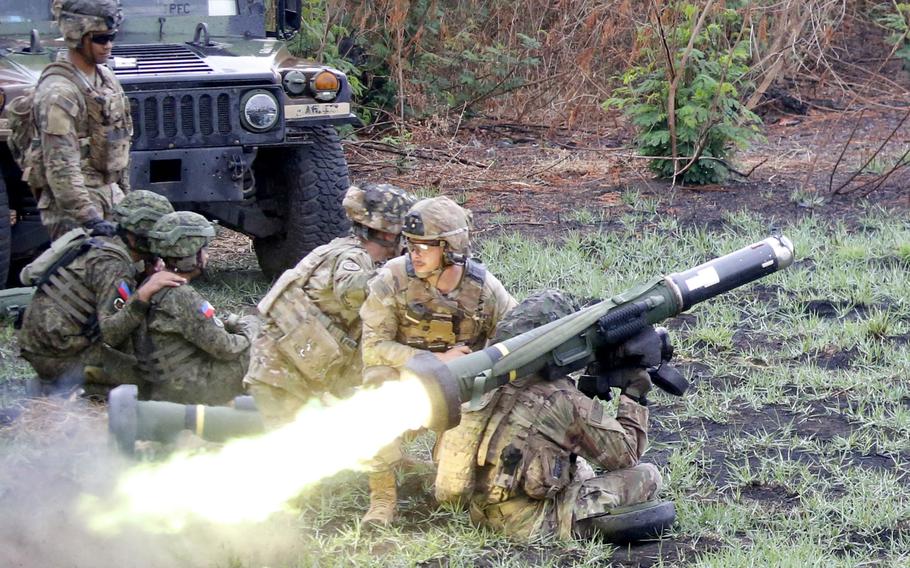
A U.S. Marine fires a Javelin anti-tank missile during a Balikatan drill at Fort Magsaysay, Philippines, Thursday, April 13, 2023. (Bullit Marquez/For Stars and Stripes)
American and Filipino troops fired anti-tank missiles already proven in combat in Ukraine, Iraq and Afghanistan during live-fire training Thursday on the Philippines’ main island of Luzon.
The drill was part of the largest-ever annual Balikatan exercise, involving 17,600 troops from both nations, which kicked off Tuesday and concludes April 28. Balikatan is Tagalog for “shoulder-to-shoulder.”
During the exercise, 12,200 Americans and 5,400 Filipinos are practicing maritime security, amphibious operations, live-fire, urban and aviation operations, cyber defense, counterterrorism and humanitarian assistance and disaster relief across the Philippines.
Journalists and U.S. Army Pacific commander Gen. Charles Flynn were at Fort Magsaysay, a military training area north of Manila, for the anti-tank missile training.
Troops fired Javelins, portable missiles that follow a trajectory similar to the ancient Greek weapons and strike armored vehicles from above.
Defense contractors Raytheon and Lockheed Martin together have produced more than 50,000 Javelins, which have been in service since 1996, according to Lockheed Martin’s website.
“This is what it looks like when the U.S. and Philippine militaries come together, train together,” Flynn told reporters at Fort Magsaysay, according to The Associated Press on Friday.
“What you’re witnessing here today is really operationalizing everything that our political leaders are talking about from integrated deterrence to campaigning to building an enduring advantage,” Flynn said.
The training plan included six missiles fired by troops from the U.S. Army’s 25th Infantry Division and the Philippine marines, Philippine army spokesman Col. Xerxes Trinidad said in a news release Tuesday from the government-run Philippine News Agency.
Javelin lectures and simulations were conducted during the recently concluded Salaknib exercises involving U.S. and Filipino troops from March 13 to April 4, Xerxes said.
U.S. forces have trained with Javelins throughout the Indo-Pacific during the past year.
Members of the 3rd Battalion, 7th Marine Regiment, from Twentynine Palms, Calif., were armed with Javelins when they trained in northern Australia last summer.
U.S. forces fired Javelins on the Indonesian island of Sumatra during the Super Garuda Shield exercise involving 2,000 U.S. and 2,000 Indonesian troops in August. And Marines fired Javelins on Japan’s northern island of Hokkaido in October.
In a conflict involving the Philippines, the anti-tank missiles would most likely be used to repel coastal amphibious assaults by destroying gunboats, landing craft and heavy equipment, according to Paul Buchanan, a New Zealand-based U.S. security expert.
“The goal is to prevent an adversary landing force, raise the cost of establishing a beachhead and degrade forces as they attempt to move inland,” he said by email Friday.
But the U.S. lacks the capacity to produce enough missiles to make a difference in a protracted confrontation that involves repelling multiple attacks, Buchanan said.
“Ukraine has absorbed most surplus inventory in the U.S. arsenal and again, the manufacturers are working 24/7 to replenish stock but are still lagging behind demand,” he said.
The U.S. will need time to supply game-changing numbers of Javelins to the Indo-Pacific, Buchanan said.
“When Javelins on the Philippines may come into use is a bigger question,” Ian Chong, an associate professor of political science at the National University of Singapore, said in an email Thursday.
“One thing that the Russian invasion of Ukraine demonstrates is the need for armament production,” he said. “That is an area that requires further enhancement. Currently, there is concern that places like Taiwan may not receive equipment they procured due to the understandable prioritization of Ukraine.”